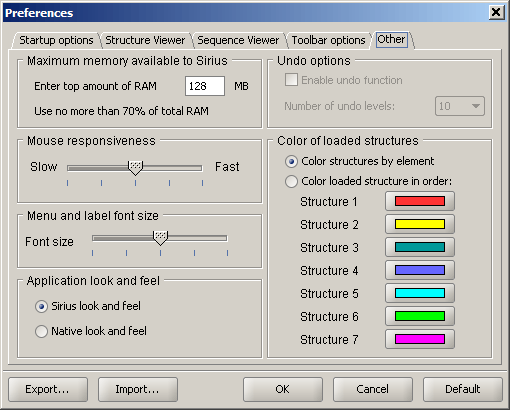Other settings

| Topic | Explanation |
| Maximum amount of memory available to Sirius | Sets the maximum amount of system memory that can be used by Sirius. The default is 128 MB, but if your system has a large RAM, you may increase this value up to 70% of the total (in order not to interfere with the operating system and cause unnecessary swapping). Increased memory allocation allows for much larger structures to be displayed and manipulated. |
| Mouse responsiveness | Sets the default mouse responsiveness for the Structure Viewer. The higher the value in the slider, the greater structure movement will be in response to a mouse motion. |
| Undo options |
Allows the user to enable/disable the undo function and set the number of undo levels. Note: undo function is based on saving states of the display before each change. Therefore, on systems with a low-performance processor or when working with very large structures, it make take a little longer for coloring, rendering or other changes. If that occurs, it is recommended to disable the undo function (unless its presense is necessary). |
| Color of loaded structures | When the default is selected, all newly loaded structures are colored by element. Alternatively, a sequential coloring scheme can be chosen. In this case, each loaded structure is displayed in a solid color. This can be useful when loading multiple structures or individual models from NMR structure or SDF files. |
| Application look and feel | Users can use this option to set application look and feel to either the Sirius default or to the OS-specific appearance. In some cases the latter may be preferred, since it sometimes produces better dialog and menu layouts. |